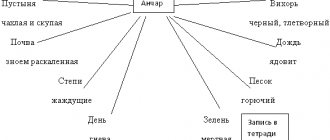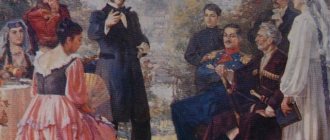The poem “Arion” occupies an important place in Pushkin’s work - with its help the poet expresses his views on the Decembrist uprising. A brief analysis of “Arion” according to plan can be used in a Russian literature lesson as main or additional material. It will help 9th grade students better understand the work.
History of creation
The work “Arion” is dedicated to the theme of the Decembrist movement. Although Pushkin himself was not a participant or organizer of the uprising, he largely supported the ideas contained in the “Manifesto to the Russian People.”
The poet created his poem in 1827, 2 years after the end of the sad events that took place on Senate Square. The text of “Arion” is metaphorical; nowhere is there a single mention of the Decembrists or royal power. Alexander Pushkin chose the myth of Arion as the main outline of the plot, thereby veiling the real meaning of his work.
The difference from the myth of Arion in Pushkin’s poem is obvious. The fate of the hero of the ancient Greek legend is very different from what happened to the lyrical subject of the poem. Arion was betrayed by the sailors, who, out of envy and greed, decided to drown their companion. He miraculously managed to escape and return to Corinth. Pushkin's hero, on the contrary, was an important member of the crew who fulfilled his role on the ship. Even though the lyrical subject was far from sailor work, he felt like part of the team. Only thanks to chance and luck was the “mysterious singer” able to get to land and escape from the disaster that overtook his comrades.
The poet himself experienced similar feelings when he wrote the text of “Arion”. Alexander Sergeevich Pushkin was close to some members of the Decembrist movement, and sometimes attended meetings of the secret society. He was always a singer who composed freedom-loving poems.
Thematic direction
The central theme that the poet reveals through his creation is the fate of the Decembrists. Their story is expressed through the images of the helmsman and rowers. The poem also makes clear reference to the great price they had to pay for trying to improve the lives of the common people of Russia.
Identifying his personality and role in the uprising, Pushkin compares himself with an ancient Greek singer. In the lines of the work, he shows that he has not at all betrayed the ideas of the Decembrists and continues to sing the same hymns.
Genre, direction, size
The lyric poem “Arion” can be classified as freedom-loving lyrics. Even if the text does not have a wide variety of tropes, it still occupies an important place in the poet’s work. The work fully fulfills its original task: it allows Alexander Sergeevich Pushkin, albeit in a metaphorical form, to express his thoughts about the suppression of the Decembrist uprising.
The meter of the poem “Arion” is iambic pentameter. The direction of his work in this case is romanticism: the lyrical hero is opposed to society, is alone and in the middle of an exotic landscape - a desert island.
Genre
Despite the allegorical nature, the work can easily be classified as civil lyric poetry. The poet speaks of the Decembrists as people who skillfully steered the ship, but were prevented by an unexpected autocratic storm. And although they paid for their courageous act, there remained a poet who would sing of their exploits and convey their ideas to the masses.
To make it easier for the reader to perceive the thoughts expressed, Pushkin uses a simple poetic meter - iambic. The encircling rhyme creates the impression of completeness of each stanza.
Images and symbols
Let's pay attention to the figurative row. The image of the “mysterious singer” strongly contrasts with the images of the other crew members. The helmsman is shown to readers as a thoughtful person who prefers to steer the boat “in silence.” Despite his important role, he remains calm, confident and focused on the task at hand. The lyrical subject, on the contrary, is careless. He is driven only by his faith, and not by any serious responsibility to the entire crew.
Physical work is also alien to the hero. He doesn't row, doesn't adjust the sail. The lyrical subject sings. Without him, the ship can continue to sail, but without a helmsman and sailors, the boat will certainly sink. The author creates such a strong contrast to show the hierarchy that existed in the Decembrist movement. The sailors were simple soldiers who believed in the ideas of a secret society and came out to the square on December 14. The feeder is a collective image. It unites all leaders of southern and northern societies. Alexander Pushkin uses inversions to place semantic accents in the text and focus readers’ attention on important images. Using this technique, the phrase “noisy whirlwind” is highlighted, denoting the Decembrist uprising. The epithet helps the author create a believable picture of raging nature.
Image system
The images of ancient myth are directly related to Pushkin’s immediate circle. “There were a lot of us on the boat,” says the poet about the Decembrists and the youth who sympathized with them.
He names Kondraty Ryleev, the writer, the inspirer of the movement, the head of the “Northern Society” as the feeder. Among Pushkin’s closest friends, formal members of the “Secret Society” included M. Lunin, M. Orlov, I. Yakushkin and others.
The harsh sentence did not spare the organizers of the uprising. Ryleev was executed along with four other leaders of the movement: P. I. Pestel, S. I. Muravyov-Apostol, M. P. Bestuzhev-Ryumin and P. G. Kakhovsky. The rest were sentenced to hard labor.
The dream of freedom cost the friends a lot, but the singer of freedom, the one through whom she found her voice, survived. The poet compares himself with the legendary ancient Greek singer , who was saved from the abyss by a dolphin who swam at his call.
Topics, problems, mood
The multi-wise Litrecon lists topics and issues in one list.
- The main theme of the poem “Arion” is the crash of the boat, which can be considered a metaphorical summary of the December events of 1825. All members of the crew died, the ship did not reach its destination, and only the poet survived the furious storm.
- The theme of the poet and poetry also sounds in the work - the lyrical hero did not fall victim to the crash, fate had mercy on him. Why? We see the answer in the meaning of the word “chasuble” - this is the attire of the clergy. The poet is equated to the priest of art and stands out from the entire team. He alone does nothing, but only sings, that is, his songs are considered sufficient grounds for staying on the ship. Apparently, his gift was highly valued by the sailors, and it was not for nothing that the elements themselves did not lay a blade over him.
- Loneliness is the state in which the poet finds himself. His ship is destroyed, his crew is killed, and he is left alone with his songs. This is the main motive of the work: the hero is sad, because one in the field is not a warrior, and his other like-minded people were washed away by the wave.
- The mood of the poem “Arion” is sad and nostalgic. The lyrical hero recalls the time when he sang and believed in the holy ideals that motivated those who sailed on this ship. He mentally mourns them and sings the old songs.
Compositions
In total, this work consists of three parts:
- The first is about friendly people who work at the same job, and also about a singer who encourages them with his magnificent singing.
- The second part describes the storm that hit the crew of the ship. Here there is a clear comparison with the courage of the Decembrists, who were not afraid to express their opinions.
- The third talks about the rescue of the singer.
main idea
The main idea of the poem “Arion” is an allegory of the Decembrist uprising, which ended in complete failure. At that time, Pushkin was in exile and could not participate in the coup, so he was not affected by arrests and exiles. But his heart was with his comrades and he wanted change with all his soul. In the poem, he reflected his mourning for those who were swallowed up by the elements of the royal wrath. He also illuminated his situation after the unsuccessful rebellion attempt: he sang the same songs, but alone.
Why then was the work “Arion” published and did not cause a public outcry, and the author himself was not punished for his lines? Most likely, Pushkin’s contemporaries interpreted the analyzed text differently. They could see in the images of the sailors ordinary people experiencing the events that happened on December 14th. Only after a while did it become clear what meaning the poet intended in the work “Arion”.
The plot of the poem
In "Arion" Pushkin talks about a singer who sails with people like him. For him, they are friends whom he supports during the voyage with his inspired songs. He sails with them and sings a song to them as they try to cope with the menacing whirlwind. These people set out on a voyage, and each performs specific functions on the ship.
They cope with various obstacles, and the singer sings his songs to them, confident that his inspired singing will help them along the way. But suddenly a storm arises and destroys their ship. And everyone died, except for the singer, who was thrown ashore. But this incident did not break his spirit; the singer continued to sing his songs.
Means of expression
The paths in the poem “Arion” are few, but very precise and expressive:
- Epithets - “powerful oars”, “clever feeder”, “carefree faith”, “noisy whirlwind”, “mysterious singer”, “former hymns”, “wet robe”.
- Metaphors - “others strained the sail,” “thrown ashore by a thunderstorm.”
- Inversions: “noisy whirlwind.”
With their help A.S. Pushkin succinctly and succinctly depicted the Decembrist uprising and noted his role in it. Aesopian language helped him avoid censorship and be heard.
Author: Diana Kuznetsova
Poetic size
iambic pentameter in his poem
This meter in literature is the most frequently used by the poet.
By analyzing, one can discover means of artistic expression:
- epithets:
“mysterious singer”, “wet robe”, “former hymns”, “powerful oars”, “careless faith”, “clever feeder”;
- metaphors:
“thrown ashore by a thunderstorm,” “others strained the sail.”
Lyrical hero
The lyrical hero of the poem is Arion, who is a metaphorical embodiment of the author himself. He feels the tragedy of what happened through the loneliness that befell him.
In the first stanza, he speaks on behalf of a certain community: “There were many of us on the boat.” The poet then describes the storm and the death of his friends.
After a miraculous rescue, he is left alone. Life itself is no longer valuable to him. It is important only because Arion will preserve the memory of the lost commonwealth in his anthems, will not betray the dream of freedom and will inspire new generations to fight.
Relevance
The relevance of the poem lies in its problematics. As before, creative people can choose the path of peace and self-sufficiency, without touching on social issues in their works, and can become spokesmen for the most pressing and painful issues of our time.
Pushkin lived the dream of freedom and paid for it with his own fate: endless exiles, constant restrictions, and the machinations of censorship.
A poet must be faithful to his chosen path in order to give the world inspiring images and ideas.
Artistic originality of the work
The sound signature of the poem is represented by alliteration with hissing and whistling consonants. The combinations “sch”, “chl”, “chn” convey the speaker’s excitement and create an atmosphere of secret collusion.
Assonances with the final “i”, “u”, “s” give rise to the mood of overcoming difficulties. It was hard for Arion, but he survived and will continue to sing.
The poem is dominated by complex sentences that describe the shipmen's relationship with the ferocious elements.
The adversative conjunctions “a” in complex sentences emphasize the special fate of the “mysterious singer”, thrown ashore by a thunderstorm.
The vocabulary of the poem almost entirely relates to commonly used vocabulary, but there are also Old Slavonic words in it:
- the helmsman is the captain of the ship standing at the stern;
- cheln – ship;
- chasuble is a swimmer's clothing.
These words set the mood in a high mood and emphasize the allegorical nature of the plot.







